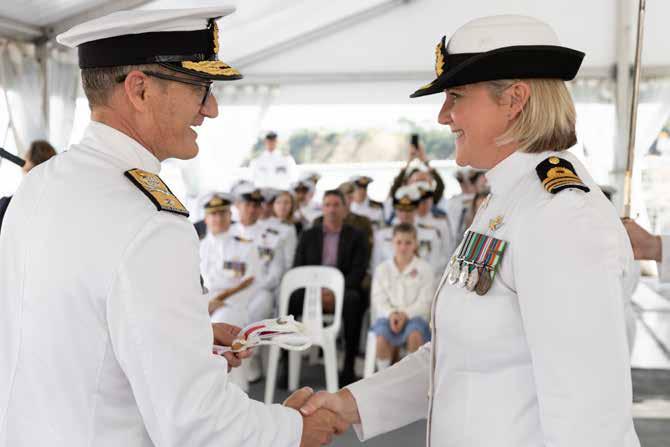
3 minute read
EXCITING TIMES FOR NEW COMMANDING OFFICER
CDR Fiona Jameson has taken command of Anzac frigate HMNZS TE KAHA, stating “I have the ship” to outgoing Commanding Officer Commander Kane Sutherland on 3 March. She is the first woman to command TE KAHA.
It’s been five years since Commander Fiona Jameson last served in an Anzac frigate. During this time the Anzacs have been on a huge modernisation journey with the FSU upgrade occurring in Canada during the Covid pandemic.
But even with the changes, she says she’s still reminded her of the familiar frigate feel – the pride, morale and personal touches that makes HMNZS TE KAHA what it is.
She joins three other female Commanding Officers of ships (see page 5) and she noted that she had always felt lucky to have strong mentors and people ahead of her to break the seas. “I’ve been able to ride in their wake. Now, as I take command with three other women, I get that slipstream of shared experience, but with a greater foundation, a greater normality around wāhine toa leadership. You don’t feel like you’re doing it alone. I’m of a generation of women that are raising each other up.”
CDR Jameson, of Tamaki-Makaurau attended High School in Whangarei, and joined the Royal New Zealand Navy in January 1999. Her Warfare Officer roles have seen her on missions to Australia, the Pacific, Asia and the Arabian Gulf, before a significant stint in the United Kingdom to qualify as a Principal Warfare Officer with deployments to the South Atlantic. She concluded her time in the UK in Warfare Officer training roles. She has since been Executive Officer of HMNZS TE MANA and HMNZS CANTERBURY, and Commanding Officer of HMNZS OTAGO. Following her Masters in Strategic Studies and promotion to Commander, CDR Jameson led the Directorate of Sea Power and Warfare. During Operation Protect, the NZDF response to the COVID-19 pandemic, CDR Jameson was Commander Task Unit North, handling 500 deployed personnel.
Command of an Anzac frigate is something she has aspired to and worked towards, she told her Ship’s Company. “I am honoured to be here and taking command. My baseline as your Commanding Officer, and I pledge to you, is that at all times I will show respect for those I am privileged to command and lead, be they sailors, soldiers, aviators or civilians. I have spoken to a few previous Commanding Officers and advice to me last Friday was simple. ‘She is a fine Ship, look after her and she will look after you.’ For me, this is about Manaaki – ‘Mana’: the individual, ‘aki’: to care for and foster. It’s about empowering and enabling every individual to play to their strengths and be their authentic best at work.”
TE KAHA’s mission is clear – to provide alongside HMNZS TE MANA the naval combat capability for New Zealand, she said.
“I’ve known JJ (CDR John McQueen, CO TE MANA) my entire career, we were at selection board together. The ships are like really strong twins, coming together to regenerate the Naval Combat Force. We’ll be supporting each other as we build up towards operational roles.”
TE KAHA has the unusual distinction of having two symbols of command, a pair of wahaika (Māori hand weapon) named Te Kaha Nui A Tiki (Tane, male) and Hine Tai Rongo Matau (wāhine, female). While both deployed together initially generally the ‘male’ has gone to sea and the ‘female’ has remained at Te Taua Moana marae to connect the Ship to the Navy’s spiritual home.
CDR Jameson chose to take “Hine Tai Rongo Matau” at the Change of Command. “It was the one that spoke to me the most. The wāhine symbol of command will ground me, while the tane will go to the marae and be the balance, connecting and supporting us, just as our families support us from home.”
Her husband, Lieutenant Commander Andrew Jameson is currently deployed as the Executive Officer of HMNZS CANTERBURY.
He will post ashore mid-year and assume the default parent role to their two children, Amy and Freya when she deploys. Like most Defence Force families, they rely on a network of support from friends, family, school, and the Navy community to make it work.


As a leader, she said she is very honest and no good at pretending to be something she’s not. “I can’t be good at everything, and it takes a huge amount of energy to try and be something you’re not good at. So I seek to leverage diversity across the team and empower everyone to contribute and bring their strengths to the table. By fostering a culture that creates a safe trusting and inclusive environment then – as a ship and its company – you can be strong. The most successful teams are not full of excellent individuals –they are the ones full of real humans who support and enable each other creating the space for individual and collective success.”









